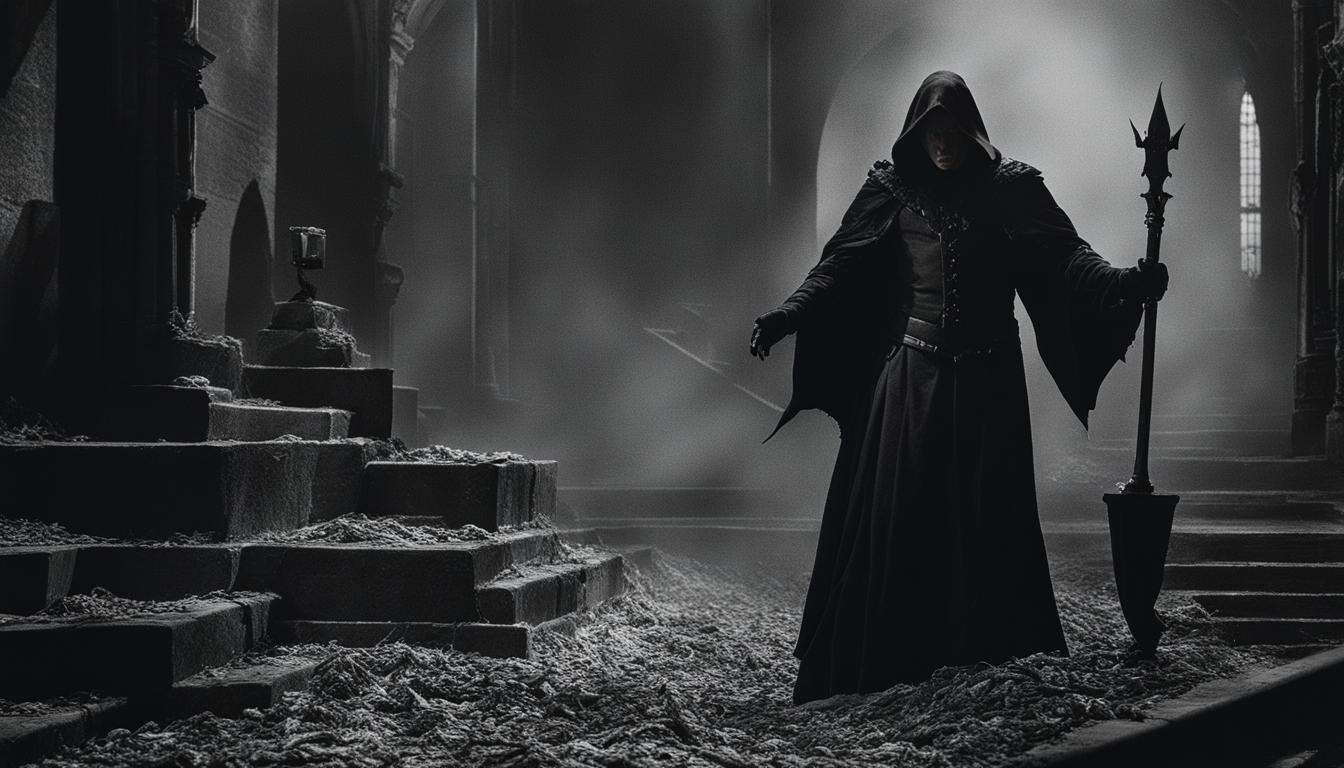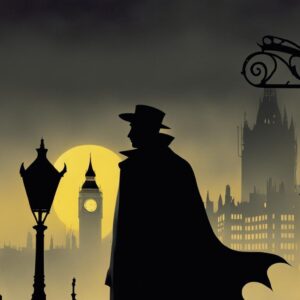Welcome to my exploration of the mesmerizing film, Faust (1926), a masterpiece of German Expressionism. Directed by F.W. Murnau, this silent film captivates audiences with its stunning visual style and supernatural themes. Drawing inspiration from Goethe’s Faust, German folklore, and literature, Faust (1926) takes us on a journey into the depths of the human soul.
In this black and white film, Murnau skillfully creates a cinematic experience that remains a classic in the realm of cinema. Through its evocative storytelling and memorable characters, Faust (1926) transports us to a world where good and evil intertwine, and the consequences of one’s choices unfold.
Join me as we delve into the supernatural realm of Faust (1926), exploring its German Expressionist roots, its connection to Goethe’s Faust, and the lasting impact it has had on the world of classic cinema.
Key Takeaways:
- Faust (1926) is a silent film directed by F.W. Murnau, known for its stunning visual style and exploration of supernatural themes.
- The film is based on Goethe’s Faust and draws inspiration from German folklore and literature.
- Faust (1926) is considered a masterpiece of German Expressionism, showcasing the artistic brilliance of F.W. Murnau.
- With its black and white cinematography and expressive storytelling, Faust (1926) remains a classic in the realm of cinema.
- Join me as we uncover the intricacies and enduring appeal of Faust (1926) and its impact on the world of cinema.
The Influence of the Faust Legend
The Faust legend has had a profound impact on literature and has been interpreted by various literary figures throughout history. The core premise of a scholar making a pact with the Devil in exchange for something has been explored as an allegory for the limits of reason, the risks of passion, and the struggle to believe. This timeless tale continues to captivate audiences and has been reimagined in countless ways.
From Johann Wolfgang von Goethe’s seminal work to modern adaptations, the Faust legend has sparked the imaginations of literary interpreters for centuries. Goethe’s version, in particular, stands out for its exploration of human desires and the consequences of pursuing them recklessly. By delving into the depths of human nature, Goethe crafted a story that resonates with readers and continues to be relevant today.
Furthermore, the Faust legend serves as a cautionary tale, urging individuals to reflect on the consequences of their actions and the choices they make. It raises profound questions about the boundaries of human knowledge, the nature of evil, and the power of redemption. As literary interpreters continue to delve into the depths of the Faust legend, they uncover new layers of meaning and inspiration that enrich our understanding of this enduring tale.
“The Faust legend is a testament to the enduring allure of stories that explore the human condition and the complexities of our desires. It serves as a reminder that we must be cautious in our pursuits, for the limits of reason, the risks of passion, and the struggle to believe are ever-present in our lives.”
The Influence of the Faust Legend
| Core Themes | Literary Figures | Major Works |
|---|---|---|
| Limits of Reason | Johann Wolfgang von Goethe | Goethe’s Faust |
| Risks of Passion | Christopher Marlowe | The Tragical History of Doctor Faustus |
| Struggle to Believe | Thomas Mann | Doctor Faustus |
F.W. Murnau’s Faust (1926)
F.W. Murnau’s Faust (1926) is a visually sophisticated film that delves into the internal and external conflicts of its protagonist, depicting Faust as a tragic Job figure. Murnau’s masterful direction combines stunning imagery with high tragedy, capturing the essence of Goethe’s timeless tale.
In this adaptation, Faust is driven to defy God in order to save his city from the plague. Murnau’s portrayal of Faust’s internal conflict is expertly intertwined with the external world, showcasing the struggle between good and evil. The film’s visuals, such as plague-addled crowds and doomsday prophets, create a rough-textured physicality that enhances the emotional impact of the story.
| Visual Elements | Emotional Impact |
|---|---|
| Plague-addled crowds | Evoke a sense of desperation and chaos |
| Doomsday prophets | Create a sense of impending doom |
| Powerful portrayal of Mephisto | Enhances the sinister presence of evil |
Faust (1926) is a testament to Murnau’s ability to push the boundaries of cinematic storytelling. The film’s combination of visually striking imagery and powerful narrative themes cements its status as a classic in the realm of German Expressionism. It remains a must-see for cinephiles and a lasting testament to Murnau’s artistic brilliance.
The Devil and Daniel Webster and Other Cinematic Interpretations
Faust has inspired many filmmakers beyond F.W. Murnau’s iconic adaptation. One notable example is The Devil and Daniel Webster (1941), directed by William Dieterle. This film presents a Faustian tale set in an American folk narrative, depicting the story of a struggling farmer who sells his soul to the Devil for prosperity. It explores themes of morality and the consequences of making deals with supernatural forces. The film’s compelling storytelling and memorable performances bring the Faust legend to life in a unique and captivating way.
Another notable cinematic interpretation is Alias Nick Beal (1949), directed by John Farrow. This film noir morality tale reimagines the Faust legend in a shady urban landscape, where a corrupt politician is tempted by a mysterious figure named Nick Beal. The film’s dark and atmospheric visuals, along with its exploration of the Faustian pact and the struggle between good and evil, make it a compelling addition to the cinematic interpretations of Faust.
Beauty and the Devil (1950), directed by René Clair, combines elements of the Faust legend with a reflection on the legacy of fascism in Europe. The film tells the story of a struggling young poet who makes a deal with the Devil to gain wealth and fame. Clair’s visually stunning portrayal of the Faustian pact, along with its exploration of the destructive nature of greed and the pursuit of power, adds a unique dimension to the cinematic adaptations of Faust.
Table: Other Cinematic Interpretations of Faust
| Film | Director | Year |
|---|---|---|
| The Devil and Daniel Webster | William Dieterle | 1941 |
| Alias Nick Beal | John Farrow | 1949 |
| Beauty and the Devil | René Clair | 1950 |
| Faust | Aleksandr Sokurov | 2011 |
Aleksandr Sokurov’s Faust (2011) offers a dazzling and unique interpretation of the Faust legend. The film explores the struggle to escape from the confines of life and the pursuit of ultimate knowledge. Sokurov’s artistic vision and storytelling techniques create a thought-provoking and visually captivating experience, showcasing the enduring appeal of the Faustian tale.
Each of these films brings its own artistic vision and storytelling approach, adding to the rich tapestry of cinematic interpretations of Faust. From the morally complex tale of The Devil and Daniel Webster to the dark and atmospheric world of Alias Nick Beal, these films offer diverse perspectives on the timeless story of Faust and continue to captivate audiences with their unique exploration of the human condition.
German Expressionism in Film
German Expressionism emerged as an avant-garde art movement in Germany during the early 20th century. Influenced by sources such as African art and medieval woodcuts, it was a response to the horrors of World War I and a participation in the growing modern art world. German Expressionism in film is characterized by highly stylized visuals and a deliberate rejection of realism in favor of evoking emotions. The movement sought to create an artificial and heightened atmosphere to engage audiences on a deeper level.
During a time when Germany was experiencing social and political upheaval, German Expressionist filmmakers used their art to explore the complex and dark aspects of the human condition. Influenced by the works of artists such as Edvard Munch and Vincent van Gogh, these films embraced exaggerated and distorted forms, dramatic lighting, and fantastic set designs to convey the emotional and psychological states of their characters.
German Expressionist cinema often featured narratives that delved into themes of madness, alienation, and the struggle between good and evil. The highly stylized visuals and expressionistic storytelling techniques served to heighten the emotional impact of these films, making them powerful vehicles for artistic expression. By prioritizing emotions over realism, German Expressionist filmmakers were able to create a distinct visual language that continues to captivate audiences to this day.
The Impact of German Expressionism
The influence of German Expressionism in film extends far beyond its own time period. Its highly stylized visuals and emphasis on the power of emotions over realism have inspired countless filmmakers and genres. For example, the dark and atmospheric lighting techniques used in German Expressionist films greatly influenced the film noir genre that emerged in Hollywood in the 1940s and 1950s.
Furthermore, the themes and visual techniques of German Expressionism can be seen in contemporary films that explore the human psyche and delve into the depths of human emotions. The legacy of German Expressionism lives on in the work of filmmakers who continue to push the boundaries of visual storytelling and evoke powerful emotions through their films.
| Film | Release Year | Director |
|---|---|---|
| Nosferatu | 1922 | F.W. Murnau |
| The Cabinet of Dr. Caligari | 1920 | Robert Wiene |
| M | 1931 | Fritz Lang |
| Metropolis | 1927 | Fritz Lang |
| Das Cabinet des Dr. Caligari | 1920 | Robert Wiene |
The Cinematic Brilliance of The Cabinet of Dr. Caligari
The Cabinet of Dr. Caligari (1920) is a prime example of German Expressionism in film, successfully translating an avant-garde stage style to the screen. The film’s niche art design is a visual treat, carefully balancing dark and light surfaces, utilizing creative perspectives, and employing lighting effects to enhance the overall atmosphere.
The distinctive avant-garde style of The Cabinet of Dr. Caligari is a testament to the artistic innovation of German Expressionism. The film’s set design, characterized by angular and distorted shapes, creates a sense of unease and disorientation, perfectly mirroring the psychological nature of the story. The juxtaposition of dark and light surfaces adds depth and emphasis to the visual details, intensifying the overall impact.
One of the most striking aspects of The Cabinet of Dr. Caligari is its inventive use of perspective. The exaggerated angles and skewed compositions contribute to the film’s unsettling atmosphere, drawing the audience into a distorted reality. Additionally, the clever manipulation of lighting effects heightens the sense of otherworldliness, further immersing viewers in the eerie world of the film.
The Cabinet of Dr. Caligari showcases the artistic brilliance of German Expressionism, pushing the boundaries of traditional filmmaking and paving the way for future experimental cinema. Its avant-garde style, niche art design, and meticulous attention to visual details make it a true masterpiece of the genre.
The Evolution of German Expressionism
German Expressionism originally emerged as a clear-cut and deliberately artificial art style, designed to evoke emotions rather than realism. It reached its peak in the early 20th century with true German Expressionist films, characterized by painted shadows, light streaks, and stylized sets. These films, such as “Nosferatu” (1922), “The Hands of Orlac” (1924), and “Metropolis” (1927), offered a unique visual experience that blended artistry with storytelling.
The use of crazy makeup and exaggerated stylized sets became hallmarks of the genre, pushing the boundaries of the cinematic medium and creating a distinct aesthetic. German Expressionism presented a departure from conventional filmmaking at the time, embracing an intentionally artificial style that captured the imagination of audiences.
“German Expressionism revolutionized the art of filmmaking, showcasing a bold and innovative approach to storytelling. The deliberate emphasis on visual elements like makeup and sets created a world of heightened reality that still captivates audiences today.” – Film Critic
As the movement evolved, German Expressionism incorporated more realistic sets while retaining its core stylistic elements. However, the original films of the era remain iconic examples of the movement’s artistic brilliance and continue to inspire filmmakers and enthusiasts worldwide.
Reflections on German Expressionism in Film
German Expressionism in film has a distinct and colorful history, inspiring discussions and analysis among filmmakers and enthusiasts. It is a distinct art movement that evolved from a clear-cut style characterized by deliberately artificial visuals to various forms of expression in cinema. The movement’s evolution can be traced through different periods, each marked by its unique approach to visual storytelling.
One of the notable aspects of German Expressionism in film is its affinity with the evolution of silent comedy. In the early 1900s, silent comedies relied on exaggerated makeup and ethnic stereotypes for comedic effect. However, as the art form progressed, silent comedians began to embrace more modern looks and storytelling techniques. Similarly, German Expressionist films gradually shifted from purely visual representations to narratives that incorporated dark themes, dramatic lighting, and a heightened focus on emotional intensity.
The impact of German Expressionism on cinema is profound, as it continues to influence contemporary filmmakers and serve as a reference point for cinematic experimentation. From the distinctive visual aesthetics to the exploration of complex and often macabre themes, German Expressionism in film remains a fascinating and enduring chapter in the history of the medium.
| German Expressionism | Silent Comedy |
|---|---|
| Distinct art movement | Evolutionary art form |
| Deliberately artificial visuals | Exaggerated makeup |
| Dark themes and dramatic lighting | Evolution into more modern looks |
| Focus on emotional intensity | Emphasis on comedic effect |
H3: The Influence of German Expressionism on Silent Comedy
Sources:
- HiveBlog
- Silent Film Society
The Legacy of F.W. Murnau
As an influential director, F.W. Murnau left an indelible mark on the world of cinema with his groundbreaking films. Known for his mastery of German Expressionism, Murnau’s work continues to captivate audiences to this day. Notably, his iconic film “Nosferatu” (1922) redefined the horror genre and set a high standard for vampire films that followed. The film’s haunting visuals and atmospheric storytelling established Murnau as a visionary filmmaker.
Murnau further showcased his talent with films like “The Last Laugh” (1924) and “Sunrise” (1927), both of which demonstrate his ability to craft emotionally resonant narratives while pushing the boundaries of cinematic storytelling. “The Last Laugh” is a powerful exploration of human dignity and the struggles of the working class, while “Sunrise” brilliantly combines German Expressionism with a Hollywood production, resulting in a visually stunning and emotionally gripping experience.
While Murnau’s career was tragically cut short by his untimely death, his influence on the film industry is undeniable. His unique storytelling approach, visually striking compositions, and contribution to the German Expressionist movement continue to inspire filmmakers and cinephiles alike. Murnau’s legacy as a master filmmaker lives on, forever etched in the annals of cinema history.
| Director | Film | Year |
|---|---|---|
| F.W. Murnau | Nosferatu | 1922 |
| F.W. Murnau | The Last Laugh | 1924 |
| F.W. Murnau | Sunrise | 1927 |
Table: Selected films directed by F.W. Murnau.
The Tragic Desecration of F.W. Murnau’s Grave
The grave of F.W. Murnau, located in Germany, has been subject to desecration multiple times, causing dismay among fans and the film community. The most recent incident involved the theft of the director’s skull, accompanied by the presence of wax and a candle, suggesting occult ties. This act of grave robbery is not the first violation of Murnau’s resting place, as his coffin was previously vandalized in the 1970s. However, the theft of his skull has sparked a scandal and deeply affected the cemetery’s manager, who recognizes the historical significance of the filmmaker.
The desecration of Murnau’s grave is a tragic event that has drawn significant attention due to the artist’s lasting legacy. While grave robbery is rare and usually reserved for world leaders, this occurrence highlights the extent to which Murnau’s impact on cinema has resonated with individuals. The act of vandalizing and robbing the resting place of an artistic genius is a shocking and disheartening blow to the memory of F.W. Murnau and his contributions to film history.
As fans and historians mourn the loss of Murnau’s skull and grapple with the implications of this act, it is essential to remember the historical significance of the filmmaker. F.W. Murnau was a pioneer of German Expressionism and a master of cinematic storytelling. His films continue to inspire and captivate audiences, and his legacy remains intact despite this tragic desecration of his grave.
In conclusion, the theft of F.W. Murnau’s skull from his grave is a distressing and unsettling event that has shocked the film community. The desecration of his resting place is a tragic reminder of the vulnerability of artistic legacies and the importance of preserving cultural history. As we reflect on F.W. Murnau’s contributions to cinema and his enduring influence, we can only hope for justice to be served, and for his memory to be respected and cherished.
F.W. Murnau: A Cinematic Genius
When discussing the pioneers of early cinema, one cannot overlook the genius of F.W. Murnau. Known for his innovative storytelling techniques and visually striking films, Murnau left an indelible mark on the world of cinema. While some of his works, such as Dr. Jekyll and Mr. Hyde and The Hunchback and the Dancer, have been lost to time, the surviving films showcase his immense talent and artistic range.
Table: Films Directed by F.W. Murnau
| Film | Year |
|---|---|
| The Last Laugh | 1924 |
| Sunrise | 1927 |
One of Murnau’s notable works is The Last Laugh, a poignant exploration of human dignity. The film showcases Murnau’s ability to evoke deep emotions through visual storytelling, leaving a lasting impact on viewers. Another masterpiece, Sunrise, seamlessly merges German Expressionism with a Hollywood production. The film’s stunning visuals and captivating narrative cement Murnau’s status as one of cinema’s greatest visionaries.
Although some of his films are lost, the surviving works of F.W. Murnau continue to captivate audiences today. His cinematic genius and unparalleled artistic vision make him a true master of the craft. From his visually striking films to his ability to elicit powerful emotions, Murnau’s contributions to cinema remain unparalleled.
The Enduring Value of F.W. Murnau’s Films
The films of F.W. Murnau continue to hold enduring value and are cherished by cinephiles worldwide. Their timeless storytelling and visual mastery showcase the brilliance of Murnau’s direction and his contributions to film history. The preservation of Murnau’s works ensures that future generations can experience the cultural significance and artistic achievements of this cinematic pioneer.
When it comes to film preservation, F.W. Murnau’s works are of utmost importance. His films not only captivate audiences with their compelling narratives but also serve as a visual testament to his artistic vision and technical expertise. From the visually sophisticated aesthetics of “Faust” (1926) to the haunting shadows of “Nosferatu” (1922), Murnau’s films exemplify the power of cinema as an art form.
In addition to their timeless storytelling, Murnau’s films are celebrated for their visual mastery. The use of lighting, composition, and symbolism in his works creates a distinct atmosphere and enhances the emotional impact of the stories. Murnau’s ability to blend German Expressionism with Hollywood production values in films like “Sunrise” (1927) demonstrates his versatility as a filmmaker.
To further emphasize the enduring value of F.W. Murnau’s films, a collection of his works is available for free viewing. This accessibility allows a wider audience to appreciate his cinematic genius and to explore the cultural significance of his contributions to the art of filmmaking. The availability of these films ensures that Murnau’s legacy will continue to inspire and educate future generations of filmmakers and film enthusiasts.
| F.W. Murnau’s Films | Cultural Significance |
|---|---|
| Nosferatu (1922) | An iconic expressionistic horror film, considered a masterpiece of the genre. |
| Sunrise (1927) | A visually stunning and emotionally powerful love story, merging German Expressionism with Hollywood production values. |
| Faust (1926) | A cinematic marvel that showcases Murnau’s visual sophistication and storytelling prowess. |
| The Last Laugh (1924) | A poignant exploration of human dignity and the impact of societal expectations. |
Conclusion
As I conclude my exploration of the cinematic artistry of Faust (1926), I am reminded of its status as a true masterpiece of German Expressionism. Directed by F.W. Murnau, this film has left a lasting legacy in the world of cinema, captivating audiences with its influential storytelling and stunning visual style.
Faust (1926) is a true cinematic gem that takes us on a journey into the supernatural themes and dark depths of the human psyche. Murnau’s masterful direction and use of German Expressionism bring the story of Faust to life, showcasing the power of visual storytelling in its purest form.
With its timeless appeal and thought-provoking narrative, Faust (1926) continues to inspire and awe audiences to this day. It remains a testament to the artistic brilliance of F.W. Murnau and serves as a reminder of the enduring impact of German Expressionism on the world of film. It is indeed a cinematic masterpiece that deserves to be celebrated and cherished.
FAQ
What is Faust (1926)?
Faust (1926) is a silent film directed by F.W. Murnau, known for its stunning visual style and exploration of supernatural themes.
What is German Expressionism?
German Expressionism was an avant-garde art movement that emerged in Germany in the early 20th century. It sought to create an artificial and heightened atmosphere in film to engage audiences on a deeper emotional level.
Who directed Faust (1926)?
Faust (1926) was directed by F.W. Murnau, a renowned filmmaker known for his exploration of German Expressionism.
What is the Faust legend?
The Faust legend first appeared in 16th-century Germany and has been reinterpreted by various literary figures. It revolves around a scholar who sells his soul to the Devil in exchange for something, serving as an allegory for the limits of reason, risks of passion, and struggles with belief.
What other films are related to the Faust legend?
Some other films related to the Faust legend include The Devil and Daniel Webster (1941), Alias Nick Beal (1949), Beauty and the Devil (1950), and Aleksandr Sokurov’s Faust (2011).
What is The Cabinet of Dr. Caligari (1920)?
The Cabinet of Dr. Caligari (1920) is a prime example of German Expressionism in film. It showcases a niche art design, carefully balancing dark and light surfaces, utilizing creative perspectives, and employing lighting effects to enhance the overall atmosphere.
What is the legacy of F.W. Murnau?
F.W. Murnau was an influential director known for his exploration of German Expressionism. His films, such as Nosferatu, The Last Laugh, and Sunrise, showcase his unique storytelling abilities and artistic range.
What happened to F.W. Murnau’s grave?
F.W. Murnau’s grave has been subject to desecration multiple times, with the most recent incident involving the theft of the director’s skull, accompanied by occult symbolism, shocking the cemetery’s manager and the artistic community.
How can I watch F.W. Murnau’s films?
Several of F.W. Murnau’s films are available for free viewing, ensuring the accessibility and appreciation of his remarkable body of work.
What is the enduring value of Faust (1926)?
Faust (1926) remains a cinematic masterpiece that captures the essence of German Expressionism and showcases F.W. Murnau’s visionary storytelling. Its stunning visuals and thought-provoking narrative make it a film worth revisiting.







